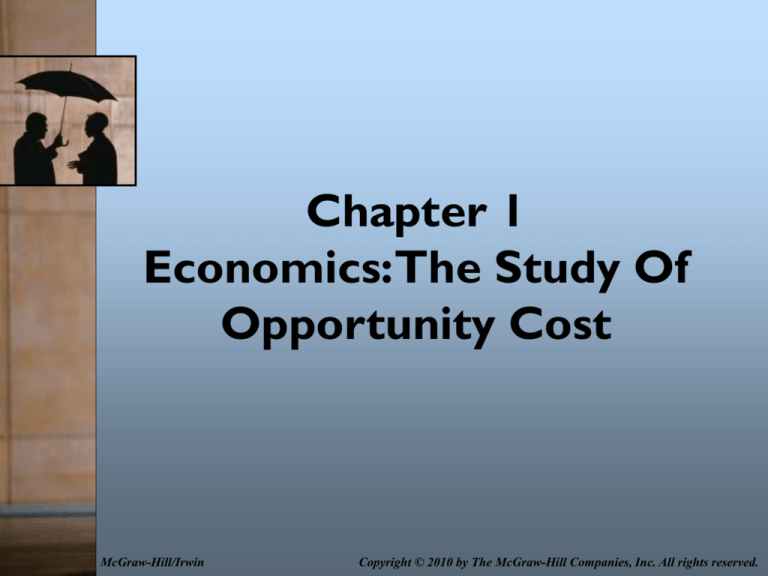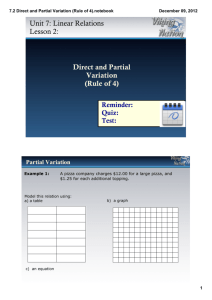
Chapter 1
Economics:The Study Of
Opportunity Cost
McGraw-Hill/Irwin
Copyright © 2010 by The McGraw-Hill Companies, Inc. All rights reserved.
CHAPTER OUTLINE
• ECONOMICS AND OPPORTUNITY COST
• MODELING OPPORTUNITY COST USING A
PRODUCTION POSSIBILITIES FRONTIER
• ATTRIBUTES OF THE PRODUCTION
POSSIBILITIES FRONTIER
• THINKING ECONOMICALLY
• Kick it Up a Notch: DEMONSTRATING
CONSTANT AND INCREASING
OPPORTUNITY COST
1-2
Economics and Opportunity Cost
• Economics: the study of the allocation
and use of scarce resources to satisfy
unlimited human wants
1-3
Choices Have Consequences
• Opportunity Cost
– The forgone alternative of the choice
made
Or
– What you would have done had you not
done what you did.
1-4
Modeling Opportunity Cost Using a Production
Possibilities Frontier Definitions
• PPF: a graph which relates the amounts of different
goods that can be produced in a fully employed
society
• Model: a simplification of the real world that we can
manipulate to explain the real world
• Simplifying Assumption: an assumption that may, on
its face, be silly but allows for a clearer explanation
• Scarce: not freely available and infinite
• Resources: anything we either consume directly or
use to make things that we will ultimately consume
1-5
Soda
Figures 1-4 Building The Production
Possibilities Frontier
S
X
Y
M
Z
P
0
Pizza
1-6
Soda
A Fully Labeled Production Possibilities Frontier:
The Case When People are Different
S
Unattainable
X
Y
Attainable
M
Z
Unemployment
0
P
Pizza
1-7
Soda
Figure 5
Unattainable
(outside the curve)
Unemployment
(just inside the curve)
0
Attainable
(on the curve and on the inside)
Pizza
1-8
Soda
A Fully Labeled Production Possibilities
Frontier: The Case When People are the Same
S
X
Unattainable
Y
Attainable
M
Z
Unemployment
0
P
Pizza
1-9
Soda
Figure 6
Unattainable
(outside the curve)
Unemployment
(just inside the curve)
0
Attainable
(on the curve and on the inside)
Pizza
1-10
Increasing and
Constant Opportunity Cost
• Increasing Opportunity Cost
– Exists when the additional resources required to
produce an additional unit grows as more output is
produced.
– Likely to occur when people are different in their skills.
• Constant Opportunity Cost
– Exists when the additional resources required to
produce an additional unit remains the same as more
output is produced.
– Likely to occur when people are identical in their skills.
1-11
The Big Picture
• circular flow model: A model that
shows the interactions of all
economic actors
– Markets are where the interactions
take place
– Actors are the entities interacting
1-12
Markets in a Circular Flow Diagram
– Market:Any mechanism by which buyers
and sellers negotiate an exchange
– Factor Market:A mechanism by which
buyers and sellers of labor and financial
capital negotiate an exchange.
– Goods and Services Market:A
mechanism by which buyers and sellers of
goods and services negotiate an exchange.
– Foreign Exchange Market: A mechanism
by which buyers and sellers of the
currencies of various countries negotiate an
exchange.
1-13
Actors in a Circular Flow Diagram
• Households
• Firms
• Government
1-14
The Circular Flow Diagram
1-15
Thinking Economically: Marginal Analysis
• Optimization Assumption: an assumption that
suggests that the person in question is trying
to maximize some objective
• Marginal Benefit: the increase in the benefit
that results from an action
• Marginal Cost: the increase in the cost that
results from an action
• Net Benefit: the difference between all
benefits and all costs
1-16
Positive and Normative Analysis
• Positive Analysis: a form of analysis
that seeks to understand the way
things are and why they are that way
• Normative Analysis: a form of analysis
that seeks to understand the ways
things should be
1-17
Economics Incentives
• Incentive: something that influences the
decisions we make
– Examples: prices influence the amount we
buy; taxes influence how much we work
and save
1-18
Logical Flaws
• Fallacy of Composition: the mistake in logic
that suggests that the total economic impact
of something is always and simply equal to
the sum of the individual parts
• Correlation = Causation: the mistake that
suggests that because two variables are
correlated that one caused the other to
happen.
1-19
Kick it Up a Notch
Demonstrating Increasing and
Constant Opportunity Cost
1-20
Soda
Figure 7 Illustrating Increasing Opportunity
Cost
Opportunity Cost of going from 0 units of
Pizza to 1 unit of pizza
10
9
8
7
6
5
4
3
2
1
0
Opportunity Cost of going from 1 unit of
Pizza to 2 units of pizza
Production Possibilities Frontier
Opportunity Cost of going from 2
units of Pizza to 3 units of pizza
1
2
3
Pizza
1-21
Soda
Figure 8
Illustrating Constant Opportunity Cost
Opportunity Cost of going from 0 units of
Pizza to 1 unit of pizza
9
8
7
6
5
4
3
2
1
Opportunity Cost of going from 1 unit of
Pizza to 2 units of pizza
Production Possibilities Frontier
Opportunity Cost of going from 2
units of Pizza to 3 units of pizza
0
1
2
3
Pizza
1-22






